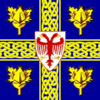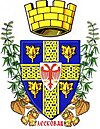Dubočica
|
Leskovac Град Лесковац |
|||
|---|---|---|---|
| City | |||
| City of Leskovac | |||

Panoramic view of Leskovac
|
|||
|
|||
 Location of the city of Leskovac within Serbia |
|||
| Coordinates: 43°00′N 21°57′E / 43.000°N 21.950°ECoordinates: 43°00′N 21°57′E / 43.000°N 21.950°E | |||
| Country |
|
||
| Region | Southern and Eastern Serbia | ||
| District | Jablanica | ||
| Settlements | 144 | ||
| Government | |||
| • Mayor | dr Goran Cvetanović (SNS) | ||
| Area | |||
| Area rank | 12th | ||
| • Administrative | 1,025 km2 (396 sq mi) | ||
| Elevation | 228 m (748 ft) | ||
| Population (2011 census) | |||
| • Rank | 5th | ||
| • Urban | 60,288 | ||
| • Administrative | 144,206 | ||
| Time zone | CET (UTC+1) | ||
| • Summer (DST) | CEST (UTC+2) | ||
| Postal code | 16000 | ||
| Area code | +381 16 | ||
| Car plates | LE | ||
| Website | www |
||
Leskovac (Serbian Cyrillic: Лесковац, pronounced [lě̞skɔ̝v̞at͡s]) is a city and the administrative center of the Jablanica District in southern Serbia. According to the 2011 census, the city urban area has 60,288 inhabitants, while the city administrative area has 144,206.
Traces of life of the Brnjica culture (8th century BC) is seen at the Hisar Hill (Hisar Leskovac) that was protected by a deep moat with a palisade on its inner side, a fortification similar to that of another fortification on the Gradac site near Zlokućane in the Velika Morava basin. A later Iron Age settlement existed at Hisar dating from the 6th century BC until the 4th century BC. Besides Greek fibula and pottery, Triballi (Thracian) tombs have been excavated in 2005.
Archeological findings from the multi-layer sites indicate that the Scordisci and Triballi inhabited the Leskovac valley before the Roman conquest in the 1st century BC. Famous cultural-historic monuments in this area are: the Roman necropolis in Mala Kopasnica originating from 2nd century AD, the Eastern Roman town of Justiniana Prima built in 535 AD.
Slavs settled the Balkans in the 6th and 7th centuries. The province was known as Dendra in Greek, and Glubočica (Глубочица, later Dubočica) in Slavic. Dendra was given to Serbian ruler Desa in 1155. It was then held by Grand Prince Stefan Nemanja.
...
Wikipedia


